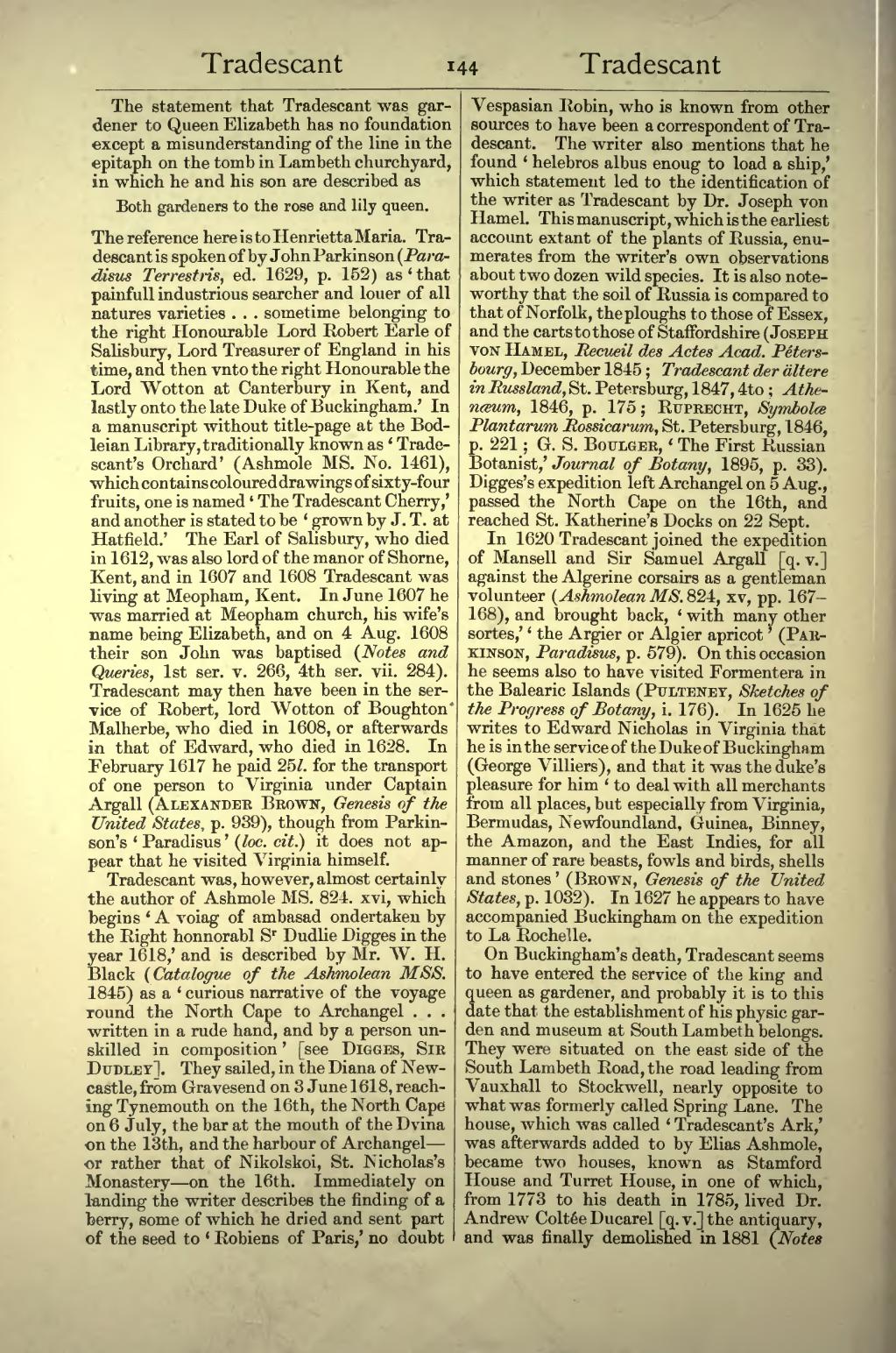The statement that Tradescant was gardener to Queen Elizabeth has no foundation except a misunderstanding of the line in the epitaph on the tomb in Lambeth churchyard, in which he and his son are described as
Both gardeners to the rose and lily queen.
The reference here is to Henrietta Maria. Tradescant is spoken of by John Parkinson (Paradisus Terrestris, ed. 1629, p. 152) as ‘that painfull industrious searcher and louer of all natures varieties … sometime belonging to the right Honourable Lord Robert Earle of Salisbury, Lord Treasurer of England in his time, and then vnto the right Honourable the Lord Wotton at Canterbury in Kent, and lastly onto the late Duke of Buckingham.’ In a manuscript without title-page at the Bodleian Library, traditionally known as ‘Tradescant's Orchard’ (Ashmole MS. No. 1461), which contains coloured drawings of sixty-four fruits, one is named ‘The Tradescant Cherry,’ and another is stated to be ‘grown by J. T. at Hatfield.’ The Earl of Salisbury, who died in 1612, was also lord of the manor of Shorne, Kent, and in 1607 and 1608 Tradescant was living at Meopham, Kent. In June 1607 he was married at Meopham church, his wife's name being Elizabeth, and on 4 Aug. 1608 their son John was baptised (Notes and Queries, 1st ser. v. 266, 4th ser. vii. 284). Tradescant may then have been in the service of Robert, lord Wotton of Boughton Malherbe, who died in 1608, or afterwards in that of Edward, who died in 1628. In February 1617 he paid 25l. for the transport of one person to Virginia under Captain Argall (Alexander Brown, Genesis of the United States, p. 939), though from Parkinson's ‘Paradisus’ (loc. cit.) it does not appear that he visited Virginia himself.
Tradescant was, however, almost certainly the author of Ashmole MS. 824. xvi, which begins ‘A voiag of ambasad ondertaken by the Right honnorabl Sr Dudlie Digges in the year 1618,’ and is described by Mr. W. H. Black (Catalogue of the Ashmolean MSS. 1845) as a ‘curious narrative of the voyage round the North Cape to Archangel … written in a rude hand, and by a person unskilled in composition’ [see Digges, Sir Dudley]. They sailed, in the Diana of Newcastle, from Gravesend on 3 June 1618, reaching Tynemouth on the 16th, the North Cape on 6 July, the bar at the mouth of the Dvina on the 13th, and the harbour of Archangel—or rather that of Nikolskoi, St. Nicholas's Monastery—on the 16th. Immediately on landing the writer describes the finding of a berry, some of which he dried and sent part of the seed to ‘Robiens of Paris,’ no doubt Vespasian Robin, who is known from other sources to have been a correspondent of Tradescant. The writer also mentions that he found ‘helebros albus enoug to load a ship,’ which statement led to the identification of the writer as Tradescant by Dr. Joseph von Hamel. This manuscript, which is the earliest account extant of the plants of Russia, enumerates from the writer's own observations about two dozen wild species. It is also noteworthy that the soil of Russia is compared to that of Norfolk, the ploughs to those of Essex, and the carts to those of Staffordshire (Joseph von Hamel, Recueil des Actes Acad. Pétersbourg, December 1845; Tradescant der ältere in Russland, St. Petersburg, 1847, 4to; Athenæum, 1846, p. 175; Ruprecht, Symbolæ Plantarum Rossicarum, St. Petersburg, 1846, p. 221; G. S. Boulger, ‘The First Russian Botanist,’ Journal of Botany, 1895, p. 33). Digges's expedition left Archangel on 5 Aug., passed the North Cape on the 16th, and reached St. Katherine's Docks on 22 Sept.
In 1620 Tradescant joined the expedition of Mansell and Sir Samuel Argall [q. v.] against the Algerine corsairs as a gentleman volunteer (Ashmolean MS. 824, xv, pp. 167–168), and brought back, ‘with many other sortes,’ ‘the Argier or Algier apricot’ (Parkinson, Paradisus, p. 579). On this occasion he seems also to have visited Formentera in the Balearic Islands (Pulteney, Sketches of the Progress of Botany, i. 176). In 1625 he writes to Edward Nicholas in Virginia that he is in the service of the Duke of Buckingham (George Villiers), and that it was the duke's pleasure for him ‘to deal with all merchants from all places, but especially from Virginia, Bermudas, Newfoundland, Guinea, Binney, the Amazon, and the East Indies, for all manner of rare beasts, fowls and birds, shells and stones’ (Brown, Genesis of the United States, p. 1032). In 1627 he appears to have accompanied Buckingham on the expedition to La Rochelle.
On Buckingham's death, Tradescant seems to have entered the service of the king and queen as gardener, and probably it is to this date that the establishment of his physic garden and museum at South Lambeth belongs. They were situated on the east side of the South Lambeth Road, the road leading from Vauxhall to Stockwell, nearly opposite to what was formerly called Spring Lane. The house, which was called ‘Tradescant's Ark,’ was afterwards added to by Elias Ashmole, became two houses, known as Stamford House and Turret House, in one of which, from 1773 to his death in 1785, lived Dr. Andrew Coltée Ducarel [q. v.] the antiquary, and was finally demolished in 1881 (Notes
